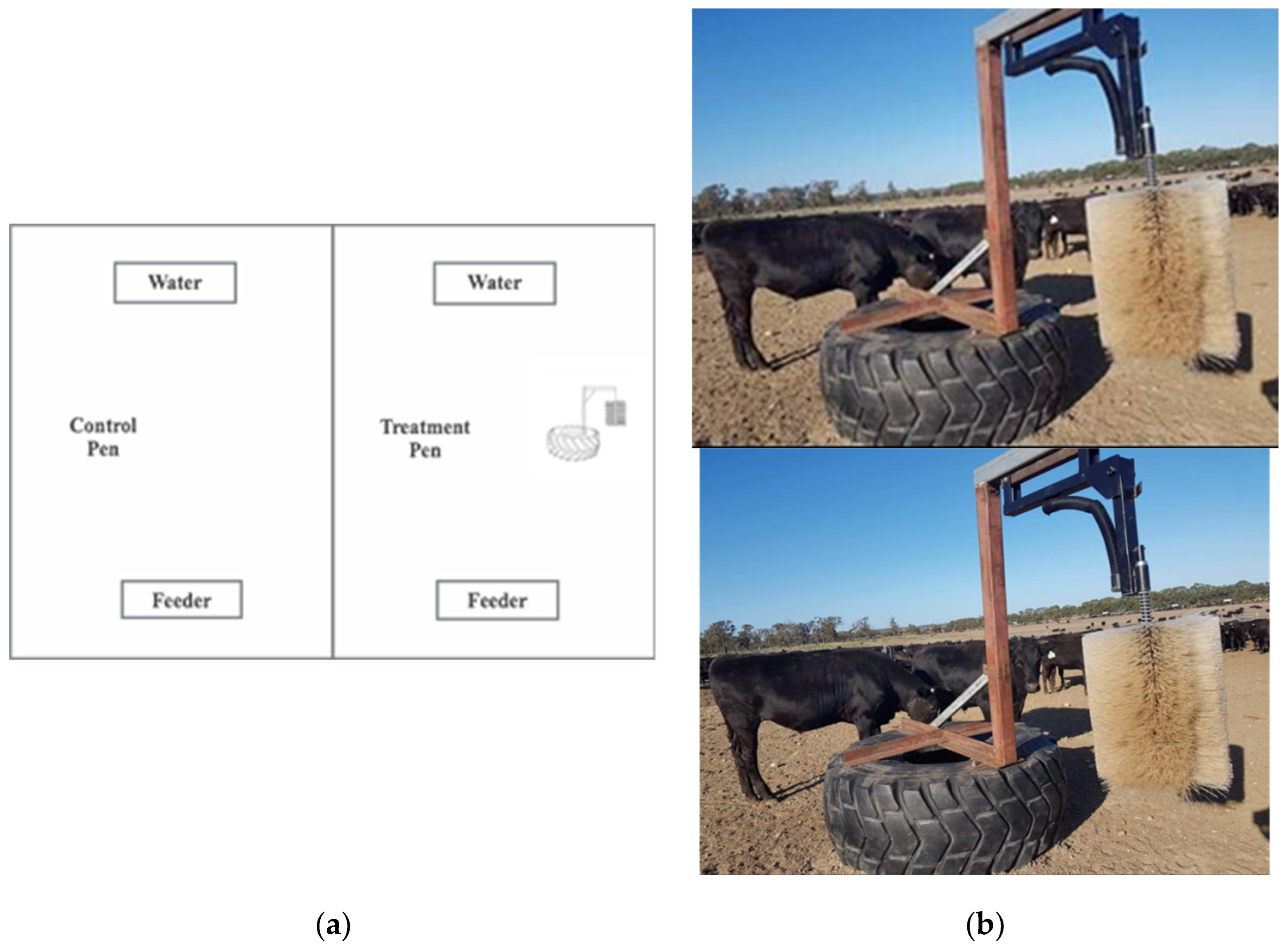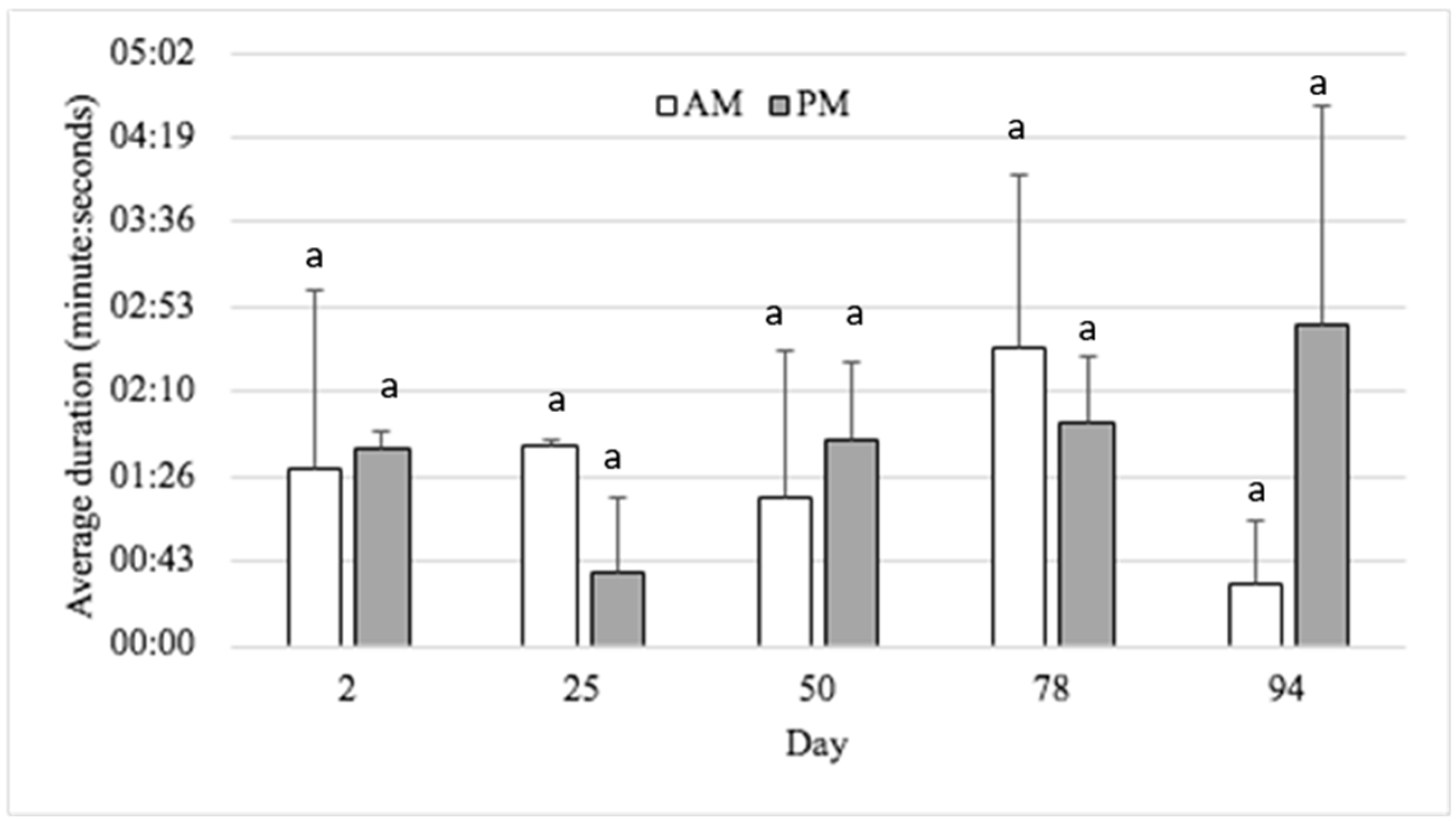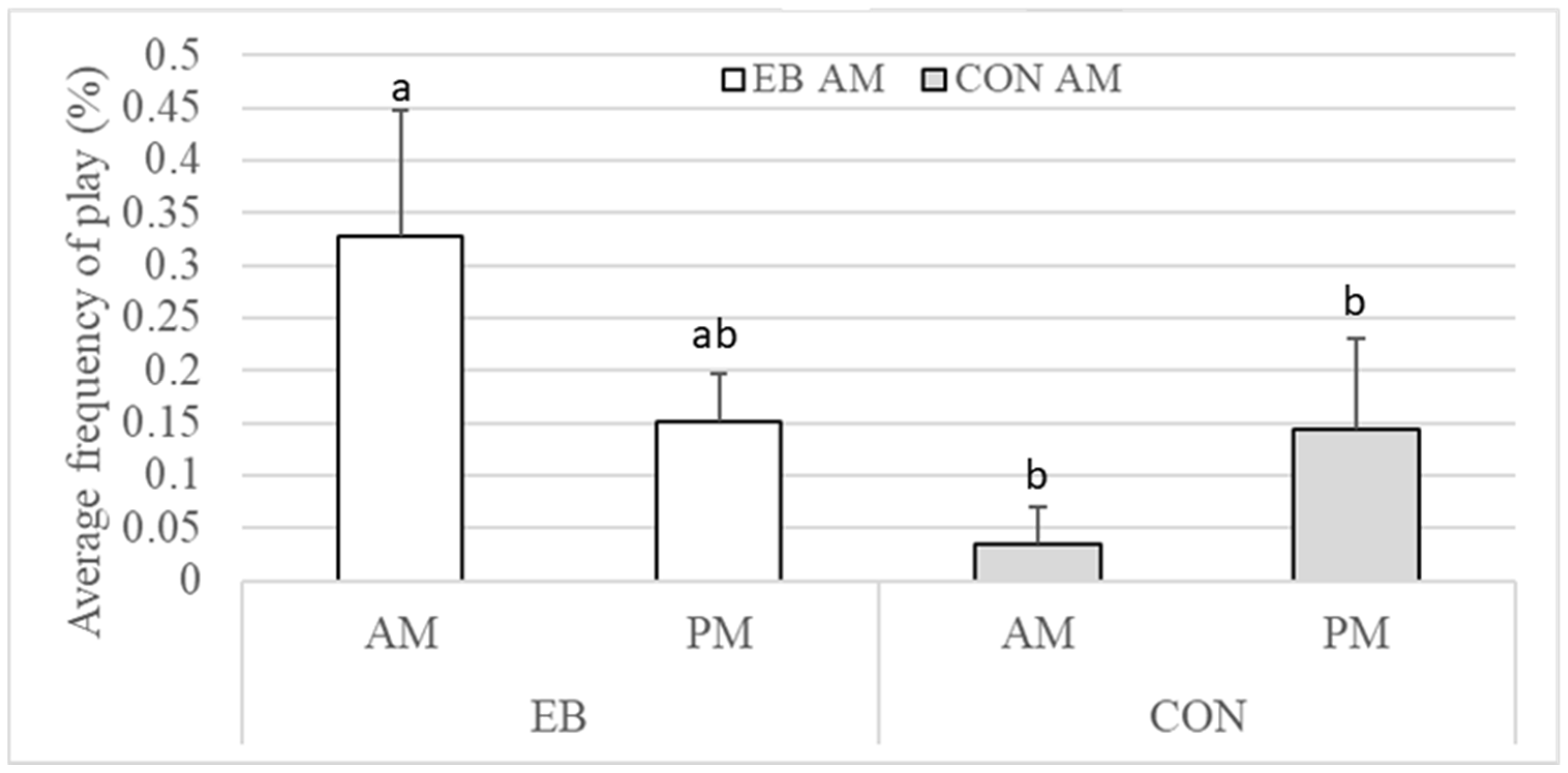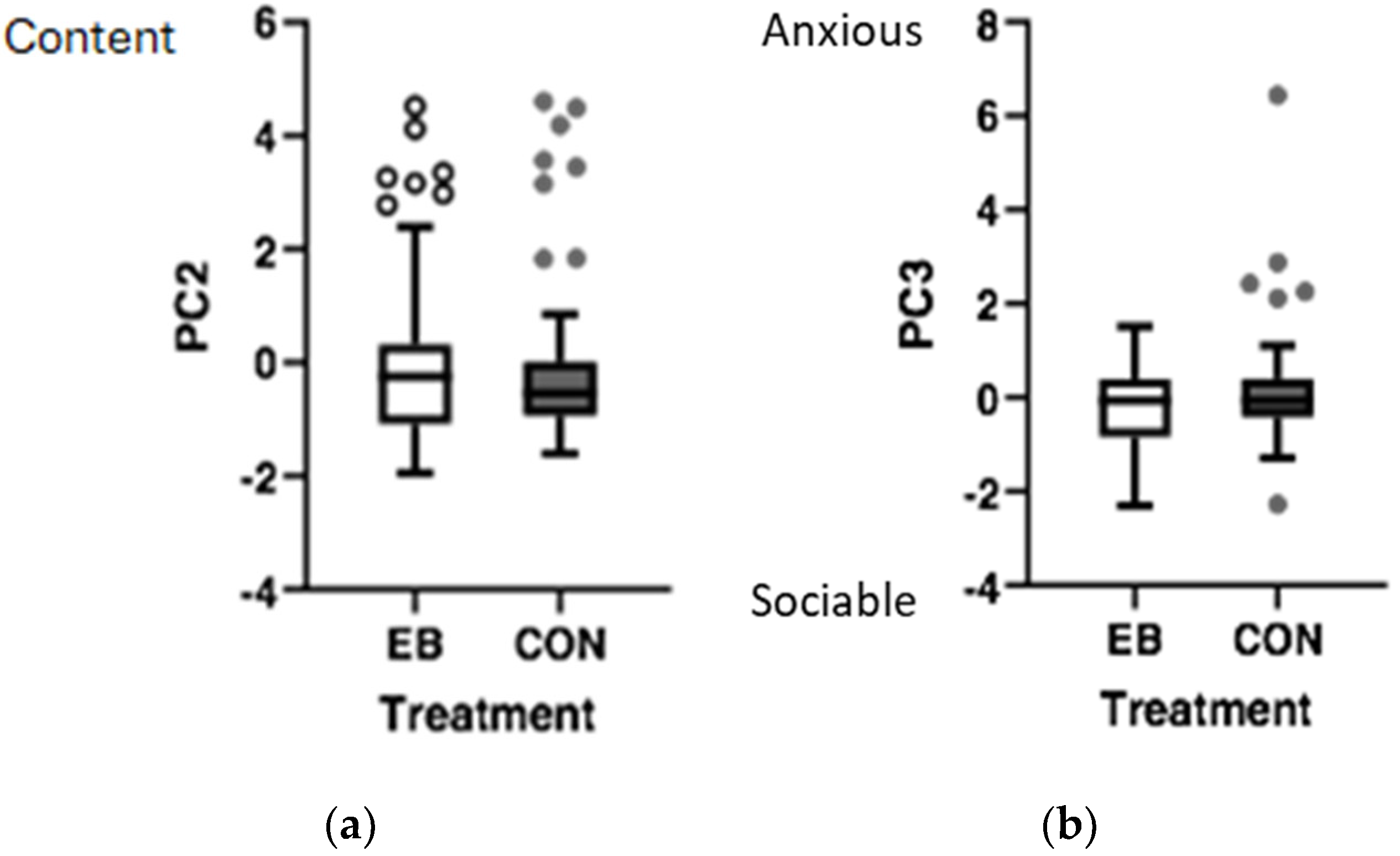Brush Use in Lot-Fed Cattle Shows Continued Use and Positive Behaviour
Simple Summary
Abstract
1. Introduction
2. Materials and Methods
2.1. Animals and Feedlot Design
2.2. Treatments
2.3. Behavioural Observations
2.4. Production and Temperament Tests
2.5. Climate
2.6. Statistical Analysis
3. Results
3.1. Ethogram Behaviour
3.2. Demeanour
3.3. Live Weight and Temperament
3.4. Climate
4. Discussion
5. Conclusions
Author Contributions
Funding
Institutional Review Board Statement
Informed Consent Statement
Data Availability Statement
Conflicts of Interest
References
- Phillips, C.J.C.; Wojciechowska, J.; Meng, J.; Cross, N. Perceptions of the importance of different welfare issues in livestock production. Animal 2009, 3, 1152–1166. [Google Scholar] [CrossRef] [PubMed]
- Spain, C.V.; Freund, D.; Mohan-Gibbons, H.; Meadow, R.G.; Beacham, L. Are They Buying It? United States Consumers’ Changing Attitudes toward More Humanely Raised Meat, Eggs, and Dairy. Animals 2018, 8, 128. [Google Scholar] [CrossRef] [PubMed]
- Salvin, H.E.; Lees, A.M.; Cafe, L.M.; Colditz, I.G.; Lee, C. Welfare of beef cattle in Australian feedlots: A review of the risks and measures. Anim. Prod. Sci. 2020, 60, 1569–1590. [Google Scholar] [CrossRef]
- Newberry, R.C. Environmental enrichment: Increasing the biological relevance of captive environments. Appl. Anim. Behav. Sci. 1995, 44, 229–243. [Google Scholar] [CrossRef]
- Mandel, R.; Whay, H.; Klement, E.; Nicol, C. Invited review: Environmental enrichment of dairy cows and calves in indoor housing. J. Dairy Sci. 2016, 99, 1695–1715. [Google Scholar] [CrossRef] [PubMed]
- Piller, C.A.; Stookey, J.M.; Watts, J.M. Effects of mirror-image exposure on heart rate and movement of isolated heifers. Appl. Anim. Behav. Sci. 1999, 63, 93–102. [Google Scholar] [CrossRef]
- Coulon, M.; Baudoin, C.; Heyman, Y.; Deputte, B.L. Cattle discriminate between familiar and unfamiliar conspecifics by using only head visual cues. Anim. Cogn. 2011, 14, 279–290. [Google Scholar] [CrossRef] [PubMed]
- Strappini, A.C.; Monti, G.; Sepúlveda-Varas, P.; de Freslon, I.; Peralta, J.M. Measuring Calves’ Usage of Multiple Environmental Enrichment Objects Provided Simultaneously. Front. Vet. Sci. 2021, 8, 698681. [Google Scholar] [CrossRef]
- Dickson, E.J.; Campbell, D.L.M.; Lee, C.; Lea, J.M.; McDonald, P.G.; Monk, J.E. Beef Cattle Preference and Usage of Environmental Enrichments Provided Simultaneously in a Pasture-Based Environment. Animals 2022, 12, 3544. [Google Scholar] [CrossRef]
- Kıyıcı, J.M.; Koçygt, R.; Tüzemen, N. The effect of classical music on milk production, milk components and milking characteristics of Holstein Friesian. J. Tekirdag Agric. Fac. 2013, 10, 74–81. [Google Scholar]
- Castro, I.M.; Gygax, L.; Wechsler, B.; Hauser, R. Increasing the interval between winter outdoor exercise aggravates agonistic interactions in Hérens cows kept in tie-stalls. Appl. Anim. Behav. Sci. 2011, 129, 59–66. [Google Scholar] [CrossRef]
- Wilson, S.; Mitlöhner, F.; Morrow-Tesch, J.; Dailey, J.; McGlone, J. An assessment of several potential enrichment devices for feedlot cattle. Appl. Anim. Behav. Sci. 2002, 76, 259–265. [Google Scholar] [CrossRef]
- DeVries, T.; Vankova, M.; Veira, D.; von Keyserlingk, M. Short Communication: Usage of Mechanical Brushes by Lactating Dairy Cows. J. Dairy Sci. 2007, 90, 2241–2245. [Google Scholar] [CrossRef] [PubMed]
- Park, R.M.; Schubach, K.M.; Cooke, R.F.; Herring, A.D.; Jennings, J.S.; Daigle, C.L. Impact of a cattle brush on feedlot steer behavior and performance. J. Anim. Sci. 2020, 98, skaa173. [Google Scholar]
- Reyes, F.S.; Gimenez, A.R.; Anderson, K.M.; Miller-Cushon, E.K.; Dorea, J.R.; Van Os, J.M.C. Impact of stationary brush quantity on brush use in group-housed dairy heifers. Animals 2022, 12, 972. [Google Scholar] [CrossRef]
- Ninomiya, S.; Sato, S. Environmental enrichment in cattle: The effects of providing a brush on the behavior and welfare of feedlot steers. Appl. Anim. Behav. Sci. 2009, 116, 141–149. [Google Scholar] [CrossRef]
- Dickson, E.J.; Monk, J.E.; Lee, C.; McDonald, P.G.; Narayan, E.; Campbell, D.L.M. Loss of a grooming enrichment impacts physical, behavioural, and physiological measures of welfare in grazing beef cattle. Animal 2024, 18, 101091. [Google Scholar] [CrossRef] [PubMed]
- Tarou, L.R.; Bashaw, M.J. Maximizing the effectiveness of environmental enrichment: Suggestions from the experimental analysis of behavior. Appl. Anim. Behav. Sci. 2007, 102, 189–204. [Google Scholar] [CrossRef]
- Dickson, E.J.; Monk, J.E.; Lee, C.; Campbell, D.L.M. Environmental enrichment during yard weaning alters the performance of calves in an attention bias and a novel object recognition test. Front. Anim. Sci. 2024, 5, 1364259. [Google Scholar] [CrossRef]
- Bruno, K.; DeSocio, E.; White, J.; Wilson, B.K. Effect of environmental enrichment devices on behavior of individually housed beef heifers. Transl. Anim. Sci. 2020, 4, txaa220. [Google Scholar] [CrossRef]
- Van Os, J.M.; Goldstein, S.A.; Weary, D.M.; von Keyserlingk, M.A. Stationary brush use in naive dairy heifers. J. Dairy Sci. 2021, 104, 12019–12029. [Google Scholar] [CrossRef] [PubMed]
- Zobel, G.; Neave, H.W.; Henderson, H.V.; Webster, J. Calves Use an Automated Brush and a Hanging Rope When Pair-Housed. Animals 2017, 7, 84. [Google Scholar] [CrossRef] [PubMed]
- DeVries, T.J.; von Keyserlingk, M.A.G.; Weary, D.M. Feeding method affects the feeding behavior of growing dairy heifers. J. Dairy Sci. 2015, 98, 180–188. [Google Scholar] [CrossRef]
- Petherick, J.C.; Holroyd, R.G.; Doogan, V.J.; Venus, B.K. Productivity, carcass and meat quality of lot-fed Bos indicus cross steers grouped according to temperament. Aust. J. Exp. Agric. 2002, 42, 389–398. [Google Scholar] [CrossRef]
- Petherick, J.C.; Doogan, V.J.; Holroyd, R.G.; Olsson, P.; Venus, B.K. Holroyd, R.G. Quality of handling and holding yard environment and beef cattle temperament: 1. Relationships with flight speed and fear of humans. Appl. Anim. Behav. Sci. 2009, 120, 18–27. [Google Scholar] [CrossRef]
- Jensen, M.B.; Pedersen, L.J.; Munksgaard, L.; Ladewig, J. The effect of environmental enrichment on the behavior of dairy calves. Appl. Anim. Behav. Sci. 1998, 56, 15–27. [Google Scholar]
- Bulens, A.; Van Beirendonck, S.; Van Thielen, J.; Buys, N.; Driessen, B. The effect of environmental enrichment on the behaviour of beef calves. Appl. Anim. Behav. Sci. 2014, 159, 1–8. [Google Scholar]
- Horvath, K.; Miller-Cushon, E. Characterizing grooming behavior patterns and the influence of brush access on the behavior of group-housed dairy calves. J. Dairy Sci. 2019, 102, 3421–3430. [Google Scholar] [CrossRef]
- Griffin, A.; Hardin, C.; Tilley, K.; Burlison, M.; McGee, M. 272 Relationships of salivary cortisol and automated brush system usage in freestall housed dairy cattle. J. Anim. Sci. 2024, 102 (Suppl. S3), 6–7. [Google Scholar] [CrossRef]
- de Oliveira, D.; Keeling, L.J. Routine activities and emotion in the life of dairy cows: Integrating body language into an affective state framework. PLoS ONE 2018, 13, e0195674. [Google Scholar] [CrossRef]
- Wemelsfelder, F.; Hunter, E.A.; Mendl, M.T.; Lawrence, A.B. The spontaneous qualitative assessment of behavioural expressions in pigs: First explorations of a novel methodology for integrative animal welfare measurement. Appl. Anim. Behav. Sci. 2000, 67, 193–215. [Google Scholar] [CrossRef]
- Dunston-Clarke, E.J.; Willis, R.S.; Fleming, P.A.; Barnes, A.L.; Miller, D.W.; Collins, T. Developing an Animal Welfare Assessment Protocol for Livestock Transported by Sea. Animals 2020, 10, 705. [Google Scholar] [CrossRef] [PubMed]
- Taylor, E.; Dunston-Clarke, E.; Brookes, D.; Jongman, E.; Ling, E.; Barnes, A.; Miller, D.; Fisher, A.; Collins, T. Application of a welfare assessment protocol for Australian lot-fed cattle: The effect of time and frequency of assessment. Appl. Anim. Behav. Sci. 2024, 277, 106349. [Google Scholar] [CrossRef]
- Wemelsfelder, F. The scientific validity of subjective concepts in models of animal welfare. Appl. Anim. Behav. Sci. 1997, 53, 75–88. [Google Scholar] [CrossRef]
- Asher, L.; Collins, L.M.; Ortiz-Pelaez, A.; Drewe, J.A.; Nicol, C.J.; Pfeiffer, D.U. Recent advances in the analysis of behavioural organization and interpretation as indicators of animal welfare. Anim. Welf. 2009, 18, 409–421. [Google Scholar] [CrossRef] [PubMed]
- Kizeo. Kizeo Forms. 2017. Available online: https://www.kizeoforms.com (accessed on 1 May 2020).
- Welfare Quality Network. Welfare Quality Assessment Protocol for Cattle. 2018. Available online: http://www.welfarequality.net/media/1088/cattle_protocol_without_veal_calves.pdf (accessed on 1 May 2020).
- Petherick, J.C.; McCosker, K.; Mayer, D.G.; Letchford, P.; McGowan, M. Evaluation of the impacts of spaying by either the dropped ovary technique or ovariectomy via flank laparotomy on the welfare of Bos indicus beef heifers and cows. J. Anim. Sci. 2013, 91, 382–394. [Google Scholar] [CrossRef]
- Grandin, T. Behavioral agitation during handling of cattle is persistent over time. Appl. Anim. Behav. Sci. 1993, 36, 1–9. [Google Scholar] [CrossRef]
- TIBCO Software Inc. Statistica, Version 14.1.0; TIBCO Software Inc.: Palo Alto, CA, USA, June 2023. [Google Scholar]
- GraphPad Software. Prism, Version 10.3.0; GraphPad Software: Boston, MA, USA, 2023; Available online: https://www.graphpad.com (accessed on 1 September 2024).
- Georg, H.; Jahn-Falk, D.; Brunswick, G.U. Technology against boredom. Landtechnik 2007, 62, 166–167. [Google Scholar]
- Georg, H.; Totschek, K. Examining an automatic cow brush for dairy cows. Landtechnik 2001, 56, 260–261. [Google Scholar]
- Newby, N.C.; Duffield, T.F.; Pearl, D.L.; Leslie, K.E.; LeBlanc, S.J.; von Keyserlingk, M.A. Short communication: Use of a mechanical brush by Holstein dairy cattle around parturition. J. Dairy Sci. 2013, 96, 2339–2344. [Google Scholar] [CrossRef] [PubMed]
- Russell, A.L.; Randall, L.V.; Kaler, J.; Eyre, N.; Thompson, J.; Green, M.J. Housed dairy cows utilise varied environmental enrichments and show diverse inter-individual variation in habituation. Appl. Anim. Behav. Sci. 2024, 274, 106241. [Google Scholar] [CrossRef]
- Færevik, G.; Andersen, I.L.; Jensen, M.B.; Bøe, K.E. Increased group size reduces conflicts and strengthens the preference for familiar group mates after regrouping of weaned dairy calves (Bos taurus). Appl. Anim. Behav. Sci. 2007, 108, 215–228. [Google Scholar] [CrossRef]
- Kohari, D.; Kosako, T.; Fukasawa, M.; Tsukada, H. Effect of environmental enrichment by providing trees as rubbing objects in grassland: Grazing cattle need tree-grooming. Anim. Sci. J. 2007, 78, 413–416. [Google Scholar] [CrossRef]
- Oliveira, D.; Franko, M.A.; Keeling, L.J. A sequential analysis of body regions and body positions during mechanical brush use by dairy cattle. J. Dairy Res. 2015, 82, 455–462. [Google Scholar]
- Meneses, X.C.A.; Park, R.M.; Ridge, E.E.; Daigle, C.L. Hourly activity patterns and behaviour-based management of feedlot steers with and without a cattle brush. Appl. Anim. Behav. Sci. 2021, 236, 105241. [Google Scholar] [CrossRef]
- Mandel, R.; Whay, H.; Nicol, C.; Klement, E. The effect of food location, heat load, and intrusive medical procedures on brushing activity in dairy cows. J. Dairy Sci. 2013, 96, 6506–6513. [Google Scholar] [CrossRef]
- Foris, B.; Sadrzadeh, N.; Krahn, J.; Weary, D.M.; von Keyserlingk, M.A.G. The Effect of Placement and Group Size on the Use of an Automated Brush by Groups of Lactating Dairy Cattle. Animals 2023, 13, 760. [Google Scholar] [CrossRef] [PubMed]
- Burton, Y.I.; Blackie, N. Impact of Lameness on Brush Use in a Loose-Housed Dairy System. Ruminants 2024, 4, 375–386. [Google Scholar] [CrossRef]
- Mandel, R.; Harazy, H.; Gygax, L.; Nicol, C.; Ben-David, A.; Whay, H.; Klement, E. Short communication: Detection of lameness in dairy cows using a grooming device. J. Dairy Sci. 2018, 101, 1511–1517. [Google Scholar] [CrossRef]
- Boissy, A.; Manteuffel, G.; Jensen, M.B.; Moe, R.O.; Spruijt, B.; Keeling, L.J.; Winckler, C.; Forkman, B.; Dimitrov, I.; Langbein, J.; et al. Assessment of positive emotions in animals to improve their welfare. Physiol. Behav. 2007, 92, 375–397. [Google Scholar] [CrossRef] [PubMed]
- Rutherford, K.M.D.; Donald, R.D.; Lawrence, A.B.; Wemelsfelder, F. Qualitative Behavioural Assessment of emotionality in pigs. Appl. Anim. Behav. Sci. 2012, 139, 218–224. [Google Scholar] [CrossRef]
- Russell, A.L.; Randall, L.V.; Kaler, J.; Eyre, N.; Green, M.J. Use of qualitative behavioural assessment to investigate affective states of housed dairy cows under different environmental conditions. Front. Vet. Sci. 2023, 10, 1099170. [Google Scholar] [CrossRef]
- Sommers, J.; Vodanovich, S.J. Boredom proneness: Its relationship to psychological- and physical-health symptoms. J. Clin. Psychol. 2000, 56, 149–155. [Google Scholar] [CrossRef]
- Vachon, P. Double Decker Enrichment cages have no effect on long term nociception in neuropathic rats but increase exploration while decreasing anxiety-like behaviors. Scand. J. Lab. Anim. Sci. 2014, 40, 1–6. [Google Scholar] [CrossRef]
- Benaroya-Milshtein, N.; Hollander, N.; Apter, A.; Kukulansky, T.; Raz, N.; Wilf, A.; Yaniv, I.; Pick, C. Environmental enrichment in mice decreases anxiety, attenuates stress responses and enhances natural killer cell activity. Eur. J. Neurosci. 2004, 20, 1341–1347. [Google Scholar] [CrossRef]
- Curley, K.O., Jr.; Neuendorff, D.A.; Lewis, A.W.; Cleere, J.J.; Welsh, T.H., Jr.; Randel, R.D. Functional characteristics of the bovine hypothalamic–pituitary–adrenal axis vary with temperament. Horm. Behav. 2008, 53, 20–27. [Google Scholar] [CrossRef] [PubMed]
- Ferguson, D.M.; Warner, R.D. Have we underestimated the impact of stress on meat quality in ruminants? Meat Sci. 2008, 80, 12–19. [Google Scholar] [CrossRef] [PubMed]
- Held, S.D.E.; Špinka, M. Animal play and animal welfare. Anim. Behav. 2011, 81, 891–899. [Google Scholar] [CrossRef]
- Stockman, C.A.; Collins, T.; Barnes, A.L.; Miller, D.; Wickham, S.L.; Verbeek, E.; Matthews, L.; Ferguson, D.; Wemelsfelder, F.; Fleming, P.A. Qualitative behavioral assessment of the motivation for feed in sheep in response to altered body condition score. Anim. Prod. Sci. 2014, 54, 922–929. [Google Scholar] [CrossRef]
- Wickham, S.L.; Collins, T.; Barnes, A.L.; Miller, D.W.; Beatty, D.T.; Stockman, C.; Blache, D.; Wemelsfelder, F.; Fleming, P.A. Qualitative behavioral assessment of transport-naïve and transport-habituated sheep. J. Anim. Sci. 2012, 90, 4523–4535. [Google Scholar] [CrossRef] [PubMed]
- Sant’Anna, A.C.; Paranhos da Costa, M.J.R. Validity and feasibility of qualitative behavior assessment for the evaluation of Nellore cattle temperament. Livest. Sci. 2013, 157, 254–262. [Google Scholar] [CrossRef]
- Tennessen, T.; Price, M.; Berg, R. The social interactions of young bulls and steers after re-grouping. Appl. Anim. Behav. Sci. 1985, 14, 37–47. [Google Scholar] [CrossRef]
- Williams, J.; Randle, H. Is the expression of stereotypic behavior a performance-limiting factor in animals? J. Vet. Behav. Clin. Appl. Res. 2017, 20, 1–10. [Google Scholar] [CrossRef]
- Van de Weerd, H.A.; Docking, C.M.; Day, J.E.L.; Avery, P.J.; Edwards, S.A. A systematic approach towards developing environmental enrichment for pigs. Appl. Anim. Behav. Sci. 2006, 99, 203–214. [Google Scholar] [CrossRef]
- Motoyama, M.; Sasaki, K.; Watanabe, A. Wagyu and the factors contributing to its beef quality: A Japanese industry overview. Meat Sci. 2016, 120, 10–18. [Google Scholar] [CrossRef] [PubMed]
- Bozkurt, Y.; Ozkaya, S.; Dew, I. Association between aggressive behaviour and high-energy feeding level in beef cattle. Czech. J. Anim. Sci. 2006, 4, 151–156. [Google Scholar] [CrossRef]
- Daigle, C.L.; Jackson, B.; Gill, R.; Wickersham, T.A.; Sawyer, J.E. Impact of exercise on productivity, behaviour, and immune functioning of weaned Bos indicus- cross calves housed in drylots. J. Anim. Sci. 2017, 95, 5230–5239. [Google Scholar] [CrossRef] [PubMed]
- Schneider, M.L. Behavioral indicators of welfare in cattle: Stereotypies and other repetitive behaviors. Vet. Clin. N. Am. Food Anim. Pract. 2020, 36, 567–582. [Google Scholar]
- Hahn, G.L. Dynamic responses of cattle to thermal heat loads. J. Anim. Sci. 1999, 77, 10–20. [Google Scholar] [CrossRef]
- Hahn, G.L.; Mader, T.L. Heat waves in relation to thermoregulation, feeding behavior and mortality of feedlot cattle. In Proceedings of the Fifth International Livestock Environment Symposium, Beijing, China, 29–31 May 1997; Bottcher, R.W., Hoff, S.J., Eds.; American Society of Agricultural Engineers: St Joseph, MO, USA, 1997; pp. 563–571. [Google Scholar]
- Yusuf, M.; Swanson, K.C.; Hanna, L.L.H.; Bauer, M.L. Understanding the relationship between weather variables and intake in beef steers. J. Anim. Sci. 2023, 101, skac423. [Google Scholar] [CrossRef] [PubMed]
- Gibbons, J.M.; Lawrence, A.B.; Haskell, M.J. Consistency of flight speed and response to restraint in a crush in dairy cattle. Appl. Anim. Behav. Sci. 2011, 131, 15–20. [Google Scholar] [CrossRef]
- Shoof International Pty. Ltd. 2023 Farmers Catalogue, Australia, 23rd ed.; Shoof International Pty. Ltd.: Melbourne, Australia, 2023. [Google Scholar]





| Ethogram behaviours (see Petherick et al. [38] for full definitions of terms) | Standing, lying (sternal or lateral), walking, resting, ruminating, vigilant, eating, drinking, aggression (mount, head butt, kick or charge), abnormal behaviour (tongue rolling, bar/fence chewing), play, push, self-grooming, brush-grooming, allogrooming, explore |
| Behaviours associated with the brush or tyre in treatment pen | Time spent with brush (seconds), frequency of use, sniffing (brush or tyre), total grooming (face (brush or tyre), rump or back) on structure, chewing (brush or tyre), displacement, queuing for access to structure, aggression, playing with structure |
| Demeanour scoring terms (see Taylor et al. [32] for full definitions of terms) | Active, agitated, alert, content, curious, dull, frustrated, settled |
| Treatment | Behaviour | Day | ||||
|---|---|---|---|---|---|---|
| 2 | 25 | 50 | 78 | 94 | ||
| Standing ^ | EB | 49.41 ± 12.65 | 66.78 ± 9.55 | 69.73 ± 6.10 | 93.65 ± 2.23 | 71.72 ± 13.03 |
| CON | 51.82 ± 11.26 | 61.88 ± 6.71 | 76.98 ± 5.60 | 89.43 ± 4.04 | 76.88 ± 14.92 | |
| Resting ^ | EB | 69.41 ± 11.37 | 71.77 ± 4.28 | 48.20 ± 8.73 | 13.07 ± 5.04 | 84.79 ± 5.36 |
| CON | 71.67 ± 4.77 | 64.14 ± 2.94 | 49.58 ± 8.98 | 2.16 ± 0.91 | 38.51 ± 13.69 | |
| Vigilant ^ | EB | 20.53 ± 10.79 | 15.38 ± 3.86 | 37.27 ± 8.23 | 73.56 ± 3.88 | 4.97 ± 1.63 |
| CON | 15.75 ± 4.38 | 25.94 ± 2.33 | 36.07 ± 7.19 | 83.93 ± 2.94 | 40.80 ± 9.56 | |
| Eating # | EB | 0.98 ± 0.50 | 1.66 ± 0.60 | 2.93 ± 1.11 | 4.48 ± 1.38 | 6.60 ± 2.17 |
| CON | 2.00 ± 1.02 | 1.30 ± 0.69 | 4.35 ± 2.08 | 2.84 ± 1.03 | 5.31 ± 2.08 | |
| Drinking ^ | EB | 0.84 ± 0.28 | 1.87 ± 0.27 | 1.92 ± 0.18 | 0.63 ± 0.17 | 0.76 ± 0.46 |
| CON | 1.12 ± 0.29 | 2.06 ± 0.27 | 2.63 ± 0.30 | 0.70 ± 0.13 | 1.32 ± 0.44 | |
| Ruminating ^ | EB | 4.75 ± 0.84 | 5.52 ± 0.79 | 5.10 ± 0.53 | 1.19 ± 0.28 | 5.28 ± 0.60 |
| CON | 7.91 ± 1.37 | 4.51 ± 0.90 | 4.92 ± 0.52 | 1.77 ± 0.25 | 4.31 ± 1.42 | |
| Playing *# | EB | 0.09 ± 0.05 | 0.21 ± 0.16 | 0.23 ± 0.16 | 0.26 ± 0.09 | 0.42 ± 0.23 |
| CON | 0.02 ± 0.02 | 0.03 ± 0.03 | 0 | 0 | 0.52 ± 0.26 | |
| Explore ^ | EB | 0.16 ± 0.07 | 0.75 ± 0.23 | 0.80 ± 0.22 | 2.93 ± 0.83 | 1.77 ± 0.61 |
| CON | 0.03 ± 0.03 | 0.21 ± 0.08 | 0.26 ± 0.13 | 2.73 ± 0.10 | 3.78 ± 2.21 | |
| Allogroom ^ | EB | 0.12 ± 0.06 | 0.63 ± 0.21 | 0.44 ± 0.18 | 0.10 ± 0.07 | 1.11 ± 0.30 |
| CON | 0.26 ± 0.15 | 0.39 ± 0.16 | 0.18 ± 0.09 | 0.13 ± 0.08 | 1.42 ± 0.33 | |
| Self-groom ^ | EB | 0.05 ± 0.03 | 0.82 ± 0.24 | 0.66 ± 0.17 | 0.68 ± 0.18 | 1.08 ± 0.29 |
| CON | 0.10 ± 0.05 | 0.78 ± 0.23 | 0.65 ± 0.13 | 0.63 ± 0.28 | 1.88 ± 0.44 | |
| Brush groom | 0.84 ± 0.32 | 0.51 ± 0.28 | 1.05 ± 0.37 | 0.73 ± 0.21 | 2.01 ± 0.68 | |
| CON | EB | |||
|---|---|---|---|---|
| d 1 | d 107 | d 1 | d 107 | |
| Live weight (kg) | 507.61 ± 3.50 a | 607.12 ± 4.70 b | 433.72 ± 3.74 a | 527.79 ± 5.15 b |
| Crush score (1–5) | 1.70 ± 0.06 a | 1.82 ± 0.06 a | 1.49 ± 0.06 b | 1.51 ± 0.03 b |
| Exit speed (seconds) | 3.42 ± 0.12 a | 3.99 ± 0.15 b | 3.20 ± 0.10 a | 3.62 ± 0.12 b |
Disclaimer/Publisher’s Note: The statements, opinions and data contained in all publications are solely those of the individual author(s) and contributor(s) and not of MDPI and/or the editor(s). MDPI and/or the editor(s) disclaim responsibility for any injury to people or property resulting from any ideas, methods, instructions or products referred to in the content. |
© 2024 by the authors. Licensee MDPI, Basel, Switzerland. This article is an open access article distributed under the terms and conditions of the Creative Commons Attribution (CC BY) license (https://creativecommons.org/licenses/by/4.0/).
Share and Cite
Dunston-Clarke, E.J.; Stockman, C.; Sinclair, J.; Collins, T. Brush Use in Lot-Fed Cattle Shows Continued Use and Positive Behaviour. Animals 2025, 15, 44. https://doi.org/10.3390/ani15010044
Dunston-Clarke EJ, Stockman C, Sinclair J, Collins T. Brush Use in Lot-Fed Cattle Shows Continued Use and Positive Behaviour. Animals. 2025; 15(1):44. https://doi.org/10.3390/ani15010044
Chicago/Turabian StyleDunston-Clarke, Emma J., Catherine Stockman, Josie Sinclair, and Teresa Collins. 2025. "Brush Use in Lot-Fed Cattle Shows Continued Use and Positive Behaviour" Animals 15, no. 1: 44. https://doi.org/10.3390/ani15010044
APA StyleDunston-Clarke, E. J., Stockman, C., Sinclair, J., & Collins, T. (2025). Brush Use in Lot-Fed Cattle Shows Continued Use and Positive Behaviour. Animals, 15(1), 44. https://doi.org/10.3390/ani15010044






